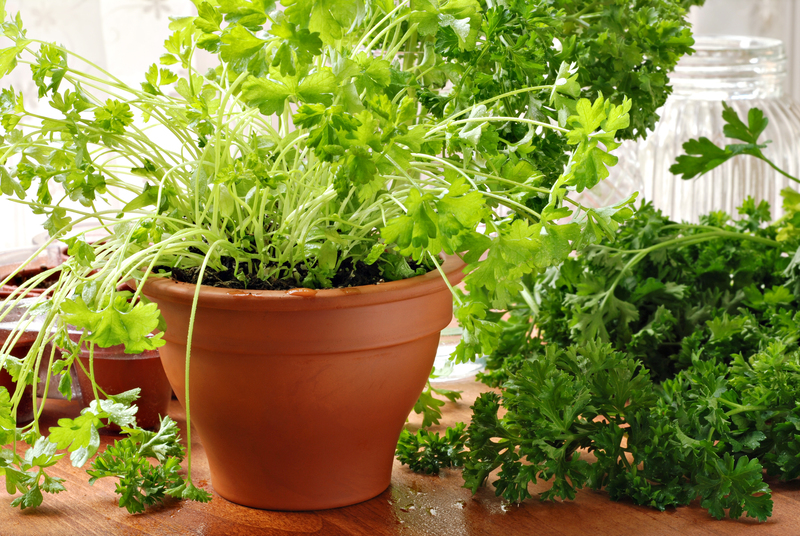Vertical Gardening: Transforming Wall Spaces into Flourishing Greenery
Posted on 03/09/2025
Vertical Gardening: Transforming Wall Spaces into Flourishing Greenery
Vertical gardening has emerged as a creative and efficient way for urban dwellers, gardeners, and design enthusiasts to revolutionize empty wall spaces into vibrant, living works of art. The trend of vertical gardens--also known as green walls, living walls, or wall gardens--enables anyone to cultivate a lush, green atmosphere regardless of space limitations. In this comprehensive guide, we'll explore everything you need to know about vertical gardening, including its benefits, design ideas, plant selection, maintenance tips, and more. Let's delve into how you can transform bare walls into bountiful, flourishing greenery.
The Rise of Vertical Gardening
Vertical gardening is not just a fleeting trend, but a practical solution to urbanization and the shrinking amount of green space in cities. Traditionally, gardening required a plot of horizontal land, but innovations in design and technology now allow plants to climb up walls, fences, interiors, and other unlikely surfaces.
Understanding Vertical Gardens
At its core, a vertical garden is a method of cultivating plants upward rather than outward, making use of vertical surfaces. They can be indoor or outdoor, large or small, and can suit almost any space--from tiny balconies to expansive office atriums.
- Vertical gardening maximizes limited space.
- These living walls can function as decorative focal points.
- They help improve air quality, reduce urban heat, and foster biodiversity.
History and Inspiration
The concept of vertical gardening is ancient; hanging gardens have long been a display of both beauty and practicality. The Hanging Gardens of Babylon, a wonder of the ancient world, is an early example. Modern techniques, pioneered by figures such as Patrick Blanc, have brought innovative and accessible green wall systems to public and residential spaces worldwide.

Benefits of Vertical Gardening
Vertical gardening offers a multitude of advantages that go beyond aesthetics. Here are some compelling reasons to integrate vertical gardens into your home or business:
- Space Efficiency: Vertical gardens allow you to utilize unused wall or fence space, making them perfect for apartments, condos, and tight spaces.
- Improved Air Quality: Plants filter pollutants and release oxygen, which can enhance the air you breathe indoors and outdoors.
- Thermal Insulation: Green walls act as a natural insulation barrier, reducing energy costs by keeping interiors cooler in summer and warmer in winter.
- Acoustic Buffer: Vertical gardens absorb sound, helping to diminish noise pollution in busy urban areas.
- Biodiversity: Living walls attract beneficial insects and birds, supporting ecosystems even in city settings.
- Aesthetic Enhancement: A vertical garden transforms bland, dull surfaces into dynamic displays of nature, instantly refreshing any space.
Types of Vertical Gardens
There are several approaches to vertical gardening, each with unique characteristics, benefits, and considerations.
1. Modular Panel Systems
Prefabricated panels or trays are installed directly onto walls, filled with growing medium and plants. These systems are popular in commercial settings due to their durability and scalability.
2. Pocket or Pouch Gardens
Fabric pockets or felt planters can be suspended and planted. These lightweight vertical gardens are ideal for herbs, flowers, and small edibles in home and office environments.
3. Trellis and Climbing Plant Arrangements
Trellis structures and wires allow vining plants such as ivy, jasmine, or clematis to climb walls naturally. This method is cost-effective and perfect for outdoor vertical gardens.
4. DIY Container Walls
Commonly fashioned from recycled materials like wooden pallets, plastic bottles, or pots, DIY vertical gardens enable customization and creativity on a budget.
5. Hydroponic Living Walls
Hydroponics-based vertical gardens use nutrient-rich water instead of soil, providing precise control over plant health and growth. These are often seen in luxury interiors and urban farming operations.
Designing Your Vertical Garden
Crafting a stunning and sustainable vertical gardening system involves strategic planning and creativity. Here's how you should approach the design:
Assess Space and Light
- Determine whether your vertical garden will be located indoors or outdoors.
- Consider how much sunlight and shade the area receives each day.
- Measure the size of your wall to match your system accordingly.
Choose a Suitable System
- Assess weight limitations and the strength of your chosen wall.
- Decide between prefab kits, pocket systems, trellises, or DIY containers based on your skills and budget.
- Plan for proper irrigation and drainage to prevent water damage.
Plan Your Plant Palette
Successful vertical gardens rely on using the right plants for the right places. Always consider:
- Light requirements (sun-loving vs. shade-tolerant)
- Growth habits (upright, cascading, climbing)
- Maintenance needs (low vs. high-care varieties)
- Aesthetic goals (texture, color, seasonal interest)
The Best Plants for Your Vertical Garden
Your choice of plants can make or break your vertical garden. Here are some top performers, categorized by their suitability for various environments:
Best Plants for Indoor Vertical Gardens
- Pothos (Epipremnum aureum) - resilient and trailing foliage
- Philodendron - diverse, lush leaves and hardy nature
- Ferns - add texture and thrive in humid conditions
- Spider Plant - easy care, air-purifying
- Peace Lily - striking white blooms, low-light tolerant
- Spathiphyllum - another term for peace lily, for SEO variety
Best Plants for Outdoor Vertical Gardens
- English Ivy - classic climber, quick to establish ground cover
- Succulents (e.g., Sedum, Echeveria) - drought tolerant, striking shapes
- Herbs (Thyme, Basil, Mint) - culinary use and aromatic appeal
- Lavender - fragrant flowers and leaves
- Flowering annuals - Petunias, Nasturtiums, Begonias
Edible Vertical Gardening
Transform your wall garden into a vertical vegetable garden with compact edibles:
- Lettuce
- Strawberries
- Chard
- Cherry tomatoes
- Radishes
- Basil, oregano, rosemary
How to Build a Vertical Garden: Step-by-Step
Ready to try wall gardening at home? Follow this step-by-step guide:
- Choose Your Location: Find a wall that receives appropriate light and can support the weight of your chosen system.
- Select a Structure: Pick your preferred type--modular panels, pocket garden, trellis, or custom DIY using recycled containers.
- Install Irrigation: For larger or indoor systems, add drip irrigation or self-watering planters to simplify maintenance.
- Prepare the Growing Medium: Use a lightweight, well-draining soil blend or hydroponic substrate for plant roots.
- Plant Selection and Arrangement: Group plants with similar light and water needs together. Position cascading varieties at the top and upright or bushy types below.
- Secure Your Plants: Place plants tightly in the medium to minimize soil loss and ensure stability.
- Monitor and Adjust: Watch for signs of under- or overwatering, and reposition plants as needed for even growth.
DIY Vertical Garden Tips
- Repurpose wooden pallets or plastic bottles for sustainable, wallet-friendly systems.
- Incorporate herbs and edibles for practical as well as ornamental benefits.
- Ensure proper drainage to avoid rot and wall damage.
- Rotate plant varieties with changing seasons for year-round color and productivity.
Maintenance & Care for Flourishing Green Walls
A thriving vertical garden requires a bit of attention, but with consistent care, your wall garden will remain stunning and healthy. Here's what you need to do:
- Watering: Check moisture levels regularly. Automated drip irrigation can simplify care for larger installations.
- Fertilizing: Provide a balanced liquid fertilizer or slow-release pellets as recommended for your plant choices.
- Pruning: Remove spent leaves or blooms, and trim overgrown plants to maintain shape and vigor.
- Pest Management: Keep an eye out for pests like aphids or spider mites, and address infestations early.
- Monitoring: Inspect your garden weekly for signs of disease, nutrient deficiencies, or structural issues.
Troubleshooting Common Issues
- Yellowing leaves: Could be overwatering, poor drainage, or nutrient deficiency.
- Leggy growth: Likely from insufficient light; try rotating your garden or supplementing with grow lights for indoor versions.
- Dropping leaves: May indicate underwatering or abrupt environmental changes.
- Rotting stems/roots: Indicates excessive moisture or poor drainage--adjust your watering habits or improve soil mix.
Creative Ideas for Vertical Gardening
Want to take your vertical gardening project to the next level? Here are inspiring concepts:
- Living Art Displays: Arrange plants in geometric patterns or use contrasting foliage colors for a painterly effect.
- Edible Wall Gardens: Mix herbs, leafy greens, and vegetables for a practical and beautiful urban farm.
- Indoor Moss Walls: Use preserved or live moss for vivid, low-maintenance greenery in bathrooms or offices.
- Pocket Herb Walls: Install on kitchen walls for fresh, year-round culinary flavor at your fingertips.
- Succulent Picture Frames: Create framed wall art with tightly packed succulents for low-water beauty.
Sustainability & Environmental Impact
Vertical gardening not only elevates your living space but also fosters positive environmental change. By greening urban environments, you help:
- Reduce the heat island effect in cities
- Filter polluted air and reduce carbon footprint
- Recycle materials through smart DIY projects
- Support pollinators and local wildlife
By embracing eco-friendly practices--such as organic substrates, water-wise systems, and native plants--your vertical garden becomes an active contributor to urban sustainability.

Vertical Gardening FAQs
- Can vertical gardens be installed indoors?
- Absolutely! With the right light conditions and plant choices, indoor vertical gardens are both beautiful and beneficial for air quality.
- How much maintenance does a wall garden require?
- With appropriate design (drip irrigation, suitable plants), maintenance is moderate--typically weekly pruning, watering, and occasional feeding.
- Will a vertical garden damage my wall?
- No, if designed with proper waterproofing, drainage, and support. Always install a barrier between the structure and the wall for protection.
- Can I grow food crops vertically?
- Definitely! Many vegetables, herbs, and even some fruits (like strawberries and tomatoes) thrive in vertical gardens.
Conclusion: Transform Your Wall into Flourishing Greenery Today
Vertical gardening offers endless possibilities for turning blank walls into lush, productive, and beautiful landscapes. Whether you are interested in reducing your carbon footprint, beautifying your home, or creating your own fresh food supply, vertical gardens provide the ultimate blend of art, horticulture, and sustainability. With the tips and insights from this article, you now have all the tools to get started. Embrace the magic of wall gardening and let your creativity flourish--your vibrant, healthy oasis awaits!
Start your journey in transforming wall spaces into flourishing greenery--experiment with designs, select your favorite plants, and watch as your vertical garden transforms your environment from dull to dynamic.



